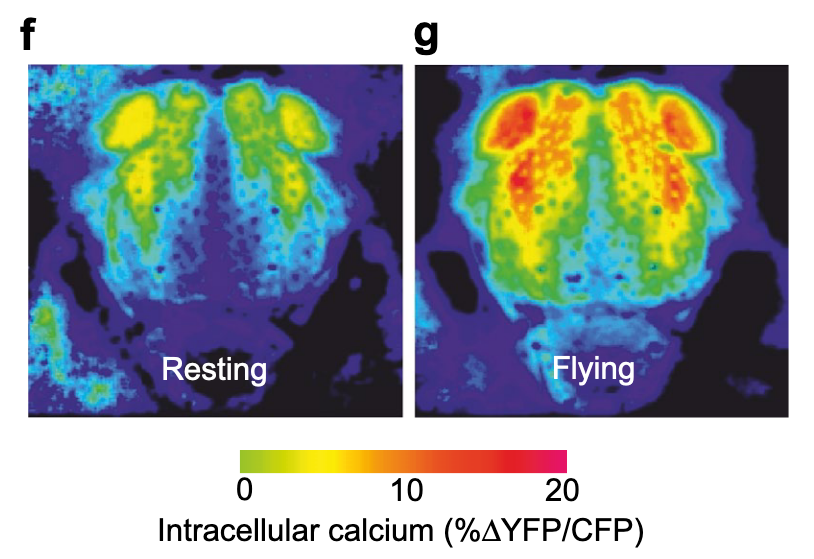Neural control and precision of flight muscle activation in Drosophila
authors: Fritz-Olaf Lehmann, Jan Bartussek
doi: 10.1007/s00359-016-1133-9
CITATION
Lehmann, F.-O., & Bartussek, J. (2017). Neural control and precision of flight muscle activation in Drosophila. Journal of Comparative Physiology A, 203(1), 1–14. https://doi.org/10.1007/s00359-016-1133-9
ABSTRACT
fleeting notes
great review article — really helps with inspiration for language and motivation of why flight is interesting and complex and worthwhile to study. highlights the many physiological challenges in neural control of flight, in particular the metabolic demands, and the sensorimotor timing to properly execute flight motor programs.
precision of motor control is crucial for evolutionary success!r
-
in invertebrates, all muscle fibers within muscle are simultaneously driven by the same or few motor neurons — see paper for references
- this keeps the question simpler and lower dimensional, more approachable and easier to understand.
-
thorax surface temp increases to more than 40 degrees C during flight due to the mechanical and frictional output of muscle contractions
-
the most metabolically active tissue in the animal kingdom is the indirect flight muscle of insects. in honey bees, the flight muscles mass requires 2500 W /kg of power
- this creates an incredible amount of evolutionary pressure
-
wing stroke of drosophila lasts 5-7 ms
highlights
“Precision of locomotor behavior is the key to the evolutionary success of animals and humans because motor control is often challenged in tasks with fastidious demands”Page 1
“In most vertebrates, muscular precision typically depends on the activity of a synergistic ensemble of numerous motor units, controlling mechanical forces and their dynamic changes via an elevated number of independently working muscle fibers and motor neurons”Page 1
“Precision of motor commands is highly relevant in a large context of various locomotor behaviors”Page 1
“sensory feedback is the basis for precise heading control and body stability in flies”Page 1
“as insects, by contrast, the number of motor units is often greatly reduced and all muscle fibers within a single muscle are simultaneously driven by the same or very few motor neurons”Page 2
“Altogether, the signal-to-noise ratio of receptors, their encoding properties, the quality of sensory integration, and the robustness of muscle contraction determine the precision with which animals finally move under both unaffected and externally perturbated locomotor conditions (”Page 2
“The importance of friction in flight, however, depends on body size because flight in small insects relatively suffers more viscous friction than the inertiadominated flight of birds and bats.”Page 2
“n dipterans, mechanical power for wing flapping is delivered by the asynchronous, indirect flight muscle (A-IFM) that generates wing motion by an indirect, mechanical linkage between muscle and wings. Wing flapping benefits from the elastic and resonance properties of the thorax shell”Page 2
“Flight control muscles, by contrast, reconfigure the wing hinge of the thoracic oscillator, controlling mechanical properties of the thorax, and thus power transmission from the A-IFM to the flapping wings via the wing hinge”Page 2
“After take-off, thorax surface temperature of flies increases from ambient temperature to more than 40 °C, changing mechanical power output in a muscle contraction work-loop 3.5-fold compared to the power produced at 20 °C ambient temperature”Page 3
“Motor skills in insects, by contrast, are widely recognized as being predominately innate, genetically programmed, fixed-action motor patterns that follow stereotyped rules.”Page 3
“The metabolic most active tissue in the animal kingdom is the A-IFM of insects, requiring metabolic power of up to ~2500 W kg−1 flight muscle mass in the honey bee”Page 6
“Since insect flight requires higher levels of mechanical power than any other form of animal locomotion, the A-IFM of Drosophila offers morphological and physiological specializations such as stretch activation and shortening deactivation at an oscillation frequency of more than 200 Hz”Page 6
“Thus, there is a continuing debate on which sensory feedback is needed for flight and how sensory information, for example, from halteres and eyes are temporally encoded to provide the desired precision for body posture, flight course control, and equilibrium reflexes”Page 7
“ing steering muscles and neck muscles are typically supplied by numerous motion-sensitive, descending interneuron via electrical synapses”Page 10
“There is an ongoing controversy on the benefits of this unusual neural design. Chemical synapses often show fatigue at high-frequency stimulation owing to a depletion of presynaptic vesicles”Page 10
“~5 and ~6.7 ms wing stroke period in Drosophila”Page 10
